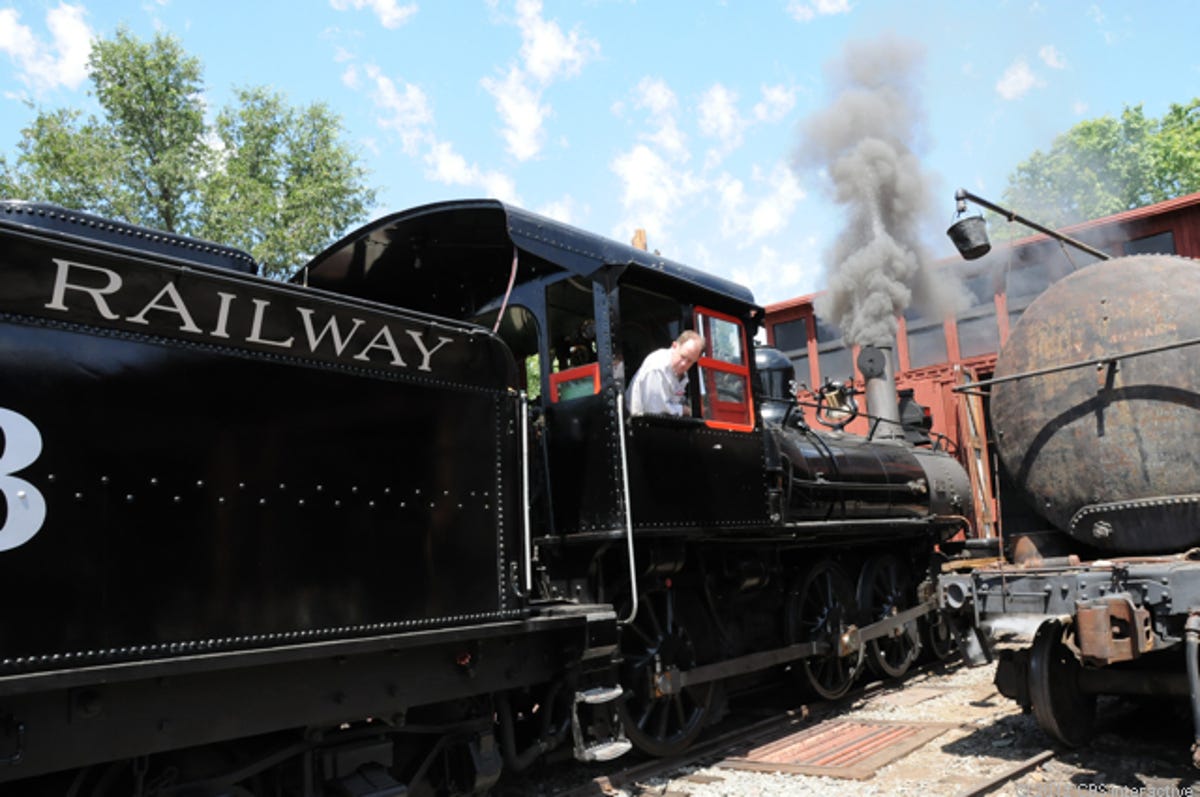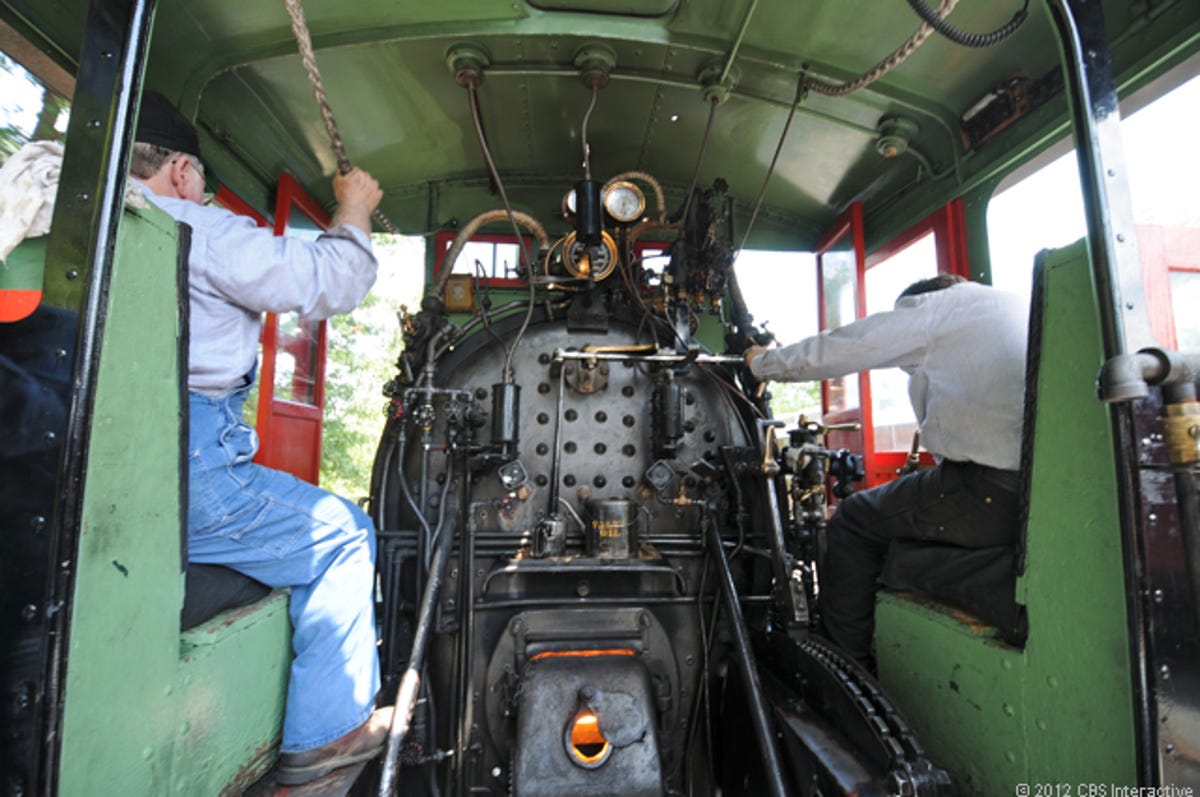'Steam nerds' keep 19th century train magic alive (pictures)
In California's Gold Country, the longest continually-running steam locomotive operation still offers a view of how the 19th century engines work. CNET Road Trip 2012 got a first-hand look.

Backing out of the roundhouse
JAMESTOWN, Calif.--For 115 years, this small Gold Country town has been home to a steam locomotive repair and maintenance facility loved by tourists and Hollywood alike.
Featured in more than 200 movies and TV shows, and a favorite of train aficionados, Railtown 1897 State Historic Park here offers the opportunity to see how steam locomotives have worked for more than a century -- and even to take a ride in a passenger car pulled by one of the venerable engines.
As part of Road Trip 2012, CNET reporter Daniel Terdiman visited Railtown and got an up-close look at how hostlers -- the hard-working people that move steam locomotives around railyards -- handle the intense heat of their job.
No. 3
Railtown maintains three steam locomotives -- No. 3, which was used to help build the Sierra Railway in 1897, and which is seen here, and Nos. 28 and 34, which were purchased for the railway in the 1920s.
Putting oil on the rag
Stephanie Tadlock, a volunteer hostler at Railtown, is a qualified fireman, meaning she has responsibility for starting, and maintaining the fire that generates the steam used to power the locomotive.
Here, Tadlock pours oil on a rag that she will light and toss into the locomotive's firebox.
Putting the rag in the firebox
After lighting the rag on fire, Tadlock prepares to toss it into the firebox, where a mixture of oil and air keeps a roaring fire burning in order to move the locomotive.
Fire gets going
After tossing in the burning rag and working to find the right mixture of oil and air, Tadlock's fire burns, slowly building up pressure.
Opening atomizer valve
Tadlock adjusts a knob to open up what is called the atomizer valve, which is used to control the mixture of oil and air inside the firebox.
Economy haze
As Tadlock works on finding the right mixture of oil and air, smoke begins to rise out of the locomotive's smokestack. Because it's not black smoke, this is called an "economy haze," Tadlock explained.
Hydrostatic lubricator
A truly steampunk-looking device, this is a hydrostatic lubricator, which provides lubricating oil to the locomotive's cylinders and its compressor.
Gauges
These three gauges provide the fireman and the engineer with information they need in order to know whether the locomotive is ready to roll. The large gauge on the bottom shows how much pressure has built up in the boiler, while the top two provide similar information about the brakes.
Tenders
These are the locomotive's tenders. On the right side -- and also out of the frame on the left -- is a round section carrying all the locomotive's water. And in the center is the container full of oil.
Fireman's manifold
This is the fireman's manifold, a set of valves used to adjust the fuel and air mixture for the locomotive's boiler.
Johnson bar
This is the "Johnson Bar," or reverser. It is used to determine the direction the locomotive moves. If pulled toward the foreground, the locomotive will move backwards. If put towards the background, it will move forward.
Adding valve oil
Hostler Dave Tadlock pours valve oil into the hydrostatic lubricator.
Letting out water
Dave Tadlock adjusts the amount of water inside the hydrostatic lubricator by opening a valve and letting it blow out.
Steam and No. 3
Steam billows out of the boiler of Railtown's No. 3 locomotive, its oldest.
319
Dave Tadlock points a device at the firebox that is used to instantly determine temperature. Inside the locomotive's cab, it can easily be 140 or 150 degrees Fahrenheit. The outer metal wall of the firebox is at 319 degrees in this picture.
Brakes
These two brass handles are used to control the locomotive's brakes. On the right is the engine brake, which is used to stop only the engine. On the left is the train brake, which stops the entire train.
On turntable
Outside the roundhouse is the Railtown turntable, which is used to determine which track the locomotives will head out on, or whether they'll come back into the shed.

Cab while driving
A look into the No. 3 locomotive's cab while it moves down the track. On the right, George Sapp, Railtown's restoration lead, is the engineer, while on the left, Dave Tadlock is the fireman.
Adjusting the throttle
Sapp adjusts the locomotive's throttle while it moves down the track.
At the depot
The No. 3 locomotive sits outside the Railtown 1897 State Historic Park's Jamestown depot.
Filling up from the water tank
Stephanie Tadlock fills the locomotive's tender with water from a large tank located near the roundhouse.
Hanging off the side
As the locomotive moves down the track, Stephanie Tadlock hangs off the side, ready to jump off and provide signals to the engineer, or to adjust the track.
Directing to the caboose
As Sapp moves the locomotive slowly toward a caboose, Stephanie Tadlock signals how far he has to go.
The caboose
Here, the locomotive has connected to the caboose.
Roundhouse
The Railtown roundhouse, which is home to three steam locomotives, including one dating to 1897, when the Sierra Railway started operations.
Sand valve
This valve is used to put sand on the tracks if they are too wet or slippery, a condition that can cause the train to slide backwards on an incline.

